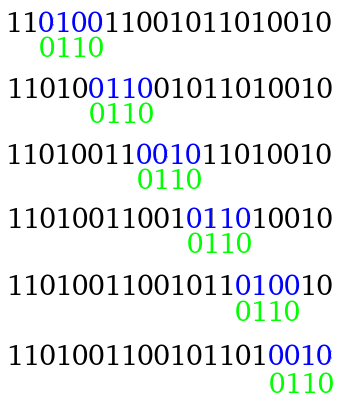Preparando MOJI
A Thue-Morse-Radecki-Mateusz sequence (Thorse-Radewoosh sequence in short) is an infinite sequence constructed from a finite sequence $$$\mathrm{gen}$$$ of length $$$d$$$ and an integer $$$m$$$, obtained in the following sequence of steps:
For instance, if we pick $$$\mathrm{gen} = (0, \color{blue}{1}, \color{green}{2})$$$ and $$$m = 4$$$:
As you can see, as long as the first element of $$$\mathrm{gen}$$$ is $$$0$$$, each consecutive step produces a sequence whose prefix is the sequence generated in the previous step. Therefore, we can define the infinite Thorse-Radewoosh sequence $$$M_\infty$$$ as the sequence obtained by applying the step above indefinitely. For the parameters above, $$$M_\infty = (0, 1, 2, 1, 2, 3, 2, 3, 0, 1, 2, 3, 2, 3, 0, 3, 0, 1, \dots)$$$.
Mateusz picked a sequence $$$\mathrm{gen}$$$ and an integer $$$m$$$, and used them to obtain a Thorse-Radewoosh sequence $$$M_\infty$$$. He then picked two integers $$$l$$$, $$$r$$$, and wrote down a subsequence of this sequence $$$A := ((M_\infty)_l, (M_\infty)_{l+1}, \dots, (M_\infty)_r)$$$.
Note that we use the $$$1$$$-based indexing both for $$$M_\infty$$$ and $$$A$$$.
Mateusz has his favorite sequence $$$B$$$ with length $$$n$$$, and would like to see how large it is compared to $$$A$$$. Let's say that $$$B$$$ majorizes sequence $$$X$$$ of length $$$n$$$ (let's denote it as $$$B \geq X$$$) if and only if for all $$$i \in \{1, 2, \dots, n\}$$$, we have $$$B_i \geq X_i$$$.
He now asks himself how many integers $$$x$$$ in the range $$$[1, |A| - n + 1]$$$ there are such that $$$B \geq (A_x, A_{x+1}, A_{x+2}, \dots, A_{x+n-1})$$$. As both sequences were huge, answering the question using only his pen and paper turned out to be too time-consuming. Can you help him automate his research?
The first line contains two integers $$$d$$$ and $$$m$$$ ($$$2 \leq d \leq 20$$$, $$$2 \leq m \leq 60$$$) — the length of the sequence $$$\mathrm{gen}$$$ and an integer used to perform the modular operations. The second line contains $$$d$$$ integers $$$\mathrm{gen}_i$$$ ($$$0 \leq \mathrm{gen}_i < m$$$). It's guaranteed that the first element of the sequence $$$\mathrm{gen}$$$ is equal to zero.
The third line contains one integer $$$n$$$ ($$$1 \leq n \leq 30000$$$) — the length of the sequence $$$B$$$. The fourth line contains $$$n$$$ integers $$$B_i$$$ ($$$0 \leq B_i < m$$$). The fifth line contains two integers $$$l$$$ and $$$r$$$ ($$$1 \leq l \leq r \leq 10^{18}$$$, $$$r-l+1 \geq n$$$).
Print a single integer — the answer to the problem.
2 2 0 1 4 0 1 1 0 2 21
6
3 4 0 1 2 2 0 2 6 11
1
Thorse-Radewoosh sequence in the first example is the standard Thue-Morse sequence, so the sequence $$$A$$$ is as follows: $$$11010011001011010010$$$. Here are the places where the sequence $$$B$$$ majorizes $$$A$$$:
